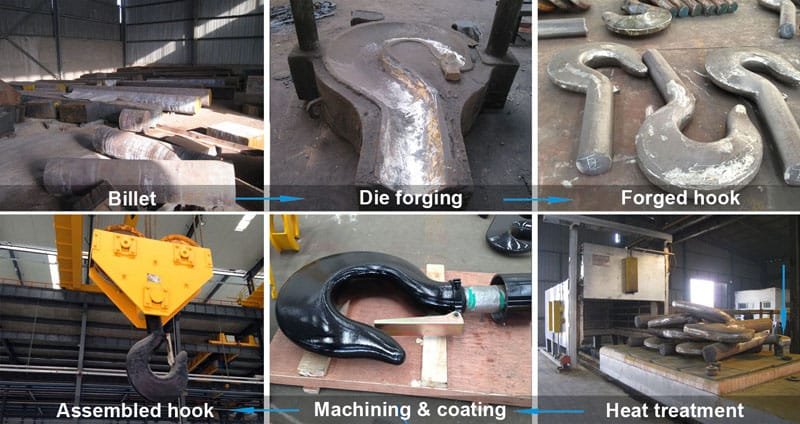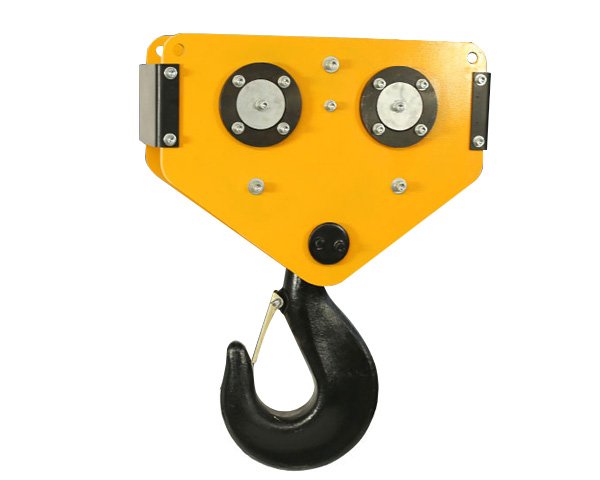
Crane Hooks
The crane hook is a critical component of cranes used for lifting and moving heavy loads. It’s typically attached to the end of the crane’s hoist wire rope and is designed to securely hold the load during lifting operations. They are usually made of high-strength steel to withstand heavy loads and rigorous use. Mainly made of alloy steel, it is divided into single hook and double hook in shape, and forged hook and laminated hook in manufacturing method.
Olatcranes provides customized Rail-mounted transfer carts, Follow German and Chinese standards.
Overview
- Shape
– C-shaped hooks: These hooks have a traditional “C” shape and are commonly used for general lifting purposes.
– S-shaped hooks: These hooks have a shape resembling the letter “S” and are often used for lifting applications where there’s a need for secure attachment.
- Design:
– Single hooks: These hooks consist of a single attachment point and are suitable for lifting lighter loads.
– Double hooks: These hooks have two attachment points, providing more stability and strength for lifting heavier loads.
- Material:
– Steel hooks: Most crane hooks are made of steel due to its strength and durability.
– Alloy hooks: Some hooks are made from alloy materials for specific applications that require lighter weight or corrosion resistance.
- Latch Mechanism:
– Latch-less hooks: These hooks lack any additional locking mechanism and are used for quick and easy attachment of loads.
– Latch-equipped hooks: These hooks come with a latch or safety mechanism to prevent the load from slipping off unintentionally.
- Specialized Hooks:
– Coil Hooks: Designed specifically for lifting coils of material such as steel coils.
– Bucket Hooks: These hooks are shaped to securely hold buckets or containers.
– Magnetized Hooks: Equipped with magnets for lifting ferrous materials without the need for slings or chains.
- Application-based Classification:
– Overhead Crane Hooks: Hooks used in overhead crane systems for lifting and moving heavy loads within a confined space.
– Shipyard Hooks: Hooks designed for use in shipyards for lifting and moving heavy ship components or containers.
– Construction Hooks: Hooks used in construction sites for lifting materials such as steel beams, concrete blocks, etc.
Please contact olatcranes to design a material handling solution for you free of charge.
Crane hooks are essential components of overhead lifting equipment used in various industries like construction, manufacturing, shipping, and logistics. They provide the primary connection between the crane and the load being lifted. Here’s a detailed look at crane hook applications:
1. Lifting Heavy Loads: The primary function of a crane hook is to lift heavy objects. These objects can range from machinery and equipment in manufacturing facilities to containers in shipping yards or construction materials on a building site. Crane hooks are designed to securely hold these loads during lifting, transferring, and lowering operations.
2. Versatility: Crane hooks come in various shapes and sizes to accommodate different types of loads and lifting configurations. Some common types include single hooks, double hooks, and specialized hooks for specific applications like lifting coils, buckets, or containers. This versatility allows crane operators to efficiently handle a wide range of materials.
3. Safety: Safety is paramount when lifting heavy loads, and crane hooks play a crucial role in ensuring safe lifting operations. They are designed with safety features such as latch mechanisms or safety latches to prevent accidental release of the load. Additionally, crane hooks are engineered with appropriate load ratings and factors of safety to handle the expected loads without failure.
4. Load Control: Crane hooks enable precise control over the movement of the load. By attaching the load to the hook and manipulating the crane’s controls, operators can raise, lower, and position the load with accuracy. This level of control is essential for tasks that require delicate handling or precise placement of heavy objects.
5. Material Handling: In industries like manufacturing and logistics, crane hooks are used for material handling tasks such as loading and unloading trucks, transferring materials within a facility, or assembling large components. Crane hooks can be attached to overhead cranes, gantry cranes, or other lifting equipment to streamline material handling processes.
6. Maintenance and Repair: Crane hooks require regular inspection, maintenance, and, if necessary, repair to ensure their continued safe operation. Maintenance tasks may include lubrication, inspection for signs of wear or damage, and load testing to verify the hook’s integrity. Proper maintenance helps prevent accidents and extends the service life of the equipment.
7. Customization: Depending on the specific application requirements, crane hooks can be customized with features such as special coatings for corrosion resistance, additional reinforcement for handling exceptionally heavy loads, or modifications for specific attachment methods. Customization ensures that the crane hook meets the unique needs of each application.
8. Training and Certification: Operating cranes and handling loads with crane hooks require specialized training and certification to ensure competence and safety compliance. Crane operators must be trained in proper lifting techniques, load calculations, equipment inspection procedures, and safety protocols to prevent accidents and injuries.
Overall, crane hooks are indispensable tools for lifting and handling heavy loads in various industrial settings. Their versatility, safety features, and precise control make them essential components of overhead lifting equipment. Proper training, maintenance, and adherence to safety standards are crucial for safe and efficient crane hook applications.
Introduction
A crane hook is a fundamental component of lifting equipment used in various industries for lifting and moving heavy loads. It serves as the primary link between the crane’s hoisting mechanism and the load being lifted. Typically made of high-strength steel, crane hooks are designed to withstand significant loads and ensure secure attachment during lifting operations.
Crane hooks come in various sizes and configurations to accommodate different load capacities and lifting requirements. They may be equipped with latch mechanisms or safety devices to prevent accidental disengagement of the load. Additionally, some crane hooks are designed for specific applications, such as lifting coils, buckets, or containers, and may incorporate specialized features to suit these purposes.
In Tcranes, crane hooks production is strictly according to the technology requirements, quality material, proper forging, machining and heat treatment. This is what we do, nothing special. To say something different, the stable quality. That is why, our crane hook is not only applied in our cranes, and applied in many other famous crane manufacturers in China.
STRENGHT CLASS | HOISTING CLASS | STRENGHT CLASS | |||||||||
M | 1Bm/M3 | 1Am/M4 | 2m/M5 | 3m/M6 | 4m/M7 | 5m/M8 | M | ||||
P | 1Bm/M3 | 1Am/M4 | 2m/M5 | 3m/M6 | 4m/M7 | 5m/M8 | P | ||||
S | 1Bm/M3 | 1Am/M4 | 2m/M5 | 3m/M6 | 4m/M7 | 5m/M8 | S | ||||
T | 1Bm/M3 | 1Am/M4 | 2m/M5 | 3m/M6 | 4m/M7 | T | |||||
V | 1Bm/M3 | 1Am/M4 | 2m/M5 | 3m/M6 | 4m/M7 | V | |||||
HOOK NO. | LOAD CAPACITY (kg) | HOOK NO. | |||||||||
006 | 320 | 250 | 200 | 160 | 125 | 100 | 006 | ||||
010 | 500 | 400 | 320 | 250 | 200 | 160 | 125 | 100 | 010 | ||
012 | 630 | 500 | 400 | 320 | 250 | 200 | 160 | 125 | 100 | 012 | |
020 | 1.000 | 800 | 630 | 500 | 400 | 320 | 250 | 200 | 160 | 125 | 020 |
025 | 1.250 | 1.000 | 800 | 630 | 500 | 400 | 320 | 250 | 200 | 160 | 025 |
04 | 2.000 | 1.600 | 1.250 | 1.000 | 800 | 630 | 500 | 400 | 320 | 250 | 05 |
05 | 2.500 | 2.000 | 1.600 | 1.250 | 1.000 | 800 | 630 | 500 | 400 | 320 | 05 |
08 | 4.000 | 3.200 | 2.000 | 2.000 | 1.600 | 1.250 | 1.000 | 800 | 630 | 500 | 08 |
1 | 5.000 | 4.000 | 3.200 | 2.000 | 2.000 | 1.600 | 1.250 | 1.000 | 800 | 630 | 1 |
1,6 | 8.000 | 6.300 | 5.000 | 4.000 | 3.200 | 2.000 | 2.000 | 1.600 | 1.250 | 1.000 | 1,6 |
2,5 | 12.500 | 10.000 | 8.000 | 6.300 | 5.000 | 4.000 | 3.200 | 2.500 | 2.000 | 1.600 | 2,5 |
4 | 20.000 | 16.000 | 12.500 | 10.000 | 8.000 | 6.300 | 5.000 | 4.000 | 3.200 | 2.500 | 4 |
5 | 25.000 | 20.000 | 16.000 | 12.500 | 10.000 | 8.000 | 6.300 | 5.000 | 4.000 | 3.200 | 5 |
6* | 32.000 | 25.000 | 20.000 | 16.000 | 12.500 | 10.000 | 8.000 | 6.300 | 5.000* | 4.000 | 6* |
8 | 40.000 | 32.000 | 25.000 | 20.000 | 16.000 | 12.500 | 10.000 | 8.000 | 6.300 | 5.000 | 8 |
10* | 50.000 | 40.000 | 32.000 | 25.000 | 20.000 | 16.000 | 12.500 | 10.000 | 8.000* | 6.300 | 10* |
12* | 63.000 | 50.000 | 40.000 | 32.000 | 25.000 | 20.000 | 16.000 | 12.500* | 10.000* | 8.000 | 12* |
16* | 80.000 | 63.000 | 50.000 | 40.000 | 32.000 | 25.000 | 20.000 | 16.000* | 12.500 | 10.000 | 16* |
20* | 100.000 | 80.000 | 63.000 | 50.000 | 40.000 | 32.000 | 25.000 | 20.000* | 16.000 | 12.500 | 20* |
25 | 125.000 | 100.000 | 80.000 | 63.000 | 50.000 | 40.000 | 32.000 | 25.000 | 20.000 | 16.000 | 25 |
32* | 160.000 | 125.000 | 100.000 | 80.000 | 63.000 | 50.000 | 40.000* | 32.000* | 25.000 | 20.000 | 32* |
40* | 200.000 | 160.000 | 125.000 | 100.000 | 80.000 | 63.000 | 50.000* | 40.000 | 32.000 | 25.000 | 40* |
50 | 250.000 | 200.000 | 160.000 | 125.000 | 100.000 | 80.000 | 63.000 | 50.000 | 40.000 | 32.000 | 50 |
63* | 320.000 | 250.000 | 200.000 | 160.000 | 125.000 | 100.000 | 80.000* | 63.000 | 50.000 | 40.000 | 63* |
80* | 400.000 | 320.00 | 250.000 | 200.000 | 160.000 | 125.000 | 100.000* | 80.000 | 63.000 | 50.000 | 80* |
100* | 500.000 | 400.000 | 320.000 | 250.000 | 200.000 | 160.000 | 125.000* | 100.000 | 80.000 | 63.000 | 100* |
125* | 500.000 | 400.000 | 320.000 | 250.000 | 200.000 | 160.000* | 125.000 | 100.000 | 80.000 | 125* | |
160* | 500.000 | 400.000 | 320.000 | 250.000 | 200.000 | 160.000 | 125.000 | 100.000 | 160* | ||
200* | 500.000 | 400.000 | 320.000 | 250.000* | 200.000 | 160.000 | 125.000 | 200* | |||
250 | 500.000 | 400.000 | 320.000* | 250.000 | 200.000 | 160.000 | 250 | ||||
Processing Technology



